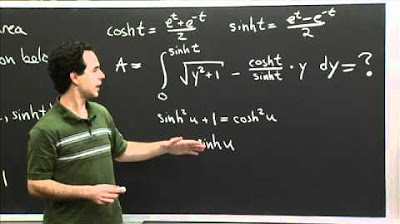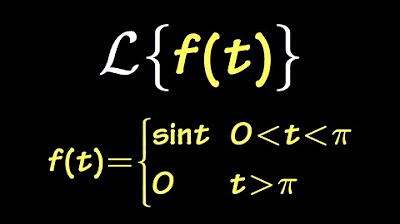Line integral example 1 | Line integrals and Green's theorem | Multivariable Calculus | Khan Academy
TLDRThe video script presents a detailed walkthrough of calculating the area of a curtain raised from a parametric curve in the xy-plane to a surface defined by a function f(xy). The curve is defined by x as cosine of t and y as sine of t, traversed from t=0 to t=π/2, effectively tracing the first quadrant of the unit circle. The area is determined using line integrals, with the integral simplified through trigonometric identities and u-substitution, ultimately yielding a result of 1/2 square units.
Takeaways
- 📐 The video discusses the concept of calculating the area of a 'curtain' using a line integral.
- 🌐 The curtain's base is defined by a parametric curve in the xy-plane, with x(t) = cos(t) and y(t) = sin(t), from t = 0 to t = π/2.
- 📈 The function f(x, y) = xy is used to define the height of the curtain from the base curve.
- 🔢 The area is found by integrating the product of the function f and the differential arc length ds along the curve.
- 📚 The differential arc length ds is expressed as √[(dx/dt)^2 + (dy/dt)^2], with dx/dt = -sin(t) and dy/dt = cos(t).
- 🔄 The integral simplifies by substituting the derivatives of x and y into the expression for ds, resulting in 1 * ds * (cos(t)sin(t)dt).
- 📶 The simplification continues with the trigonometric identity sin^2(t) + cos^2(t) = 1, which reduces the integral to ∫(sin(t)cos(t)dt) from 0 to π/2.
- 💡 A u-substitution is then used, with u = sin(t), du = cos(t)dt, allowing the integral to be solved more easily.
- 🧠 The antiderivative of sin(t)cos(t) is 1/2 * u^2, and evaluating this from u = 0 to u = 1 gives the final area of 1/2.
- 🎨 The video includes visual aids to help viewers understand the curve, the curtain, and the line integral setup.
- 📝 The process demonstrates a practical application of line integrals in calculating areas and serves as a review of concepts from a previous video.
Q & A
What is the main topic of the video?
-The main topic of the video is the calculation of the area of a surface formed by a curve in the xy-plane and a given function f(xy).
How is the curve in the xy-plane defined?
-The curve is defined parametrically by x = cos(t) and y = sin(t), where t ranges from 0 to pi/2 radians.
What does the function f(xy) represent in the context of the video?
-The function f(xy) represents the height of the surface above the curve in the xy-plane at any given point (x, y).
What is the significance of the unit circle in this context?
-The unit circle is significant because the curve defined by x = cos(t) and y = sin(t) is a quarter of the unit circle in the first quadrant.
How does the video approach the problem of finding the area of the surface?
-The video approaches the problem by breaking it down into small segments, calculating the area of each segment, and then summing these areas using integration.
What is the integral formula used to find the area of the surface?
-The integral formula used is ∫ from t=0 to t=pi/2 of (cos(t) * sin(t)) * sqrt((cos(t)')^2 + (sin(t)')^2) dt, where cos(t)' is the derivative of cos(t) with respect to t, and sin(t)' is the derivative of sin(t) with respect to t.
What are the derivatives of x and y with respect to t?
-The derivative of x with respect to t (cos(t)) is -sin(t), and the derivative of y with respect to t (sin(t)) is cos(t).
What trigonometric identity simplifies the integral?
-The trigonometric identity (cos(t)^2 + sin(t)^2) = 1 simplifies the integral by allowing the square root term under the integral to be replaced with 1.
What is the final result of the area calculation?
-The final result of the area calculation is 1/2 square units.
What is the significance of the result in practical terms?
-In practical terms, the result represents the area of the curtain-like surface formed by raising a fence from the curve to the height defined by the function f(xy).
How does this video contribute to the understanding of line integrals?
-This video contributes to the understanding of line integrals by providing a concrete example of how to apply the concept to calculate the area of a surface formed by a curve and a function, demonstrating the steps and calculations involved in the process.
Outlines
📐 Introduction to Parametric Equations and Unit Circle
The video begins with a transition from abstract concepts to a concrete example, focusing on a parametric equation where f(xy) = xy. The speaker introduces a path in the xy plane, specifically a curve defined by x = cosine(t) and y = sine(t), traversing from t = 0 to t = pi/2 radians, which corresponds to the first quadrant of the unit circle. The visualization of this curve is attempted, and the properties of the unit circle are discussed, such as the points reached at t = 0 and t = pi/2. The main goal is to raise a fence along this curve and find the area of the resulting curtain by using the tools from a previous video.
📈 Calculating the Area of the Curtain Using Line Integrals
In this paragraph, the speaker delves into the process of calculating the area of the curtain formed by raising a fence along the curve from the previous explanation. The method involves taking an infinite sum of small arc lengths (ds) multiplied by the height at each point, which is given by the function f(xy) at that point. The speaker rewrites the expression for ds using derivatives of x and y with respect to t and emphasizes the need to express everything in terms of t. The derivatives are found, and the integral is simplified using basic trigonometric identities, leading to a more manageable form of the integral.
🔄 Solving the Integral and Finding the Area
The speaker concludes the video by solving the integral and finding the area of the curtain. A u-substitution is performed, changing the integral to one in terms of u, where u is sine(t). The boundaries are redefined in terms of u, and the integral becomes a simple antiderivative problem. The antiderivative of u is found, and the integral is evaluated from 0 to 1, yielding a result of 1/2. This represents the area of the curtain along the curve, providing a neat application of line integrals and a satisfying conclusion to the video's mathematical exploration.
Mindmap
Keywords
💡Parametric Equation
💡Unit Circle
💡Line Integral
💡Derivative
💡Trigonometric Identities
💡Integration
💡u-Substitution
💡Area
💡Curve
💡Surface
💡Integral
Highlights
The video discusses a practical example of using a function in the xy plane, specifically f(xy) = xy.
A curve is defined in the xy plane by x = cos(t) and y = sin(t), traversed from t = 0 to t = π/2.
The curve described is the first quadrant of the unit circle with a radius of 1.
The goal is to find the area of a 'curtain' raised from the curve up to the surface defined by f(xy).
The method involves integrating the function over the curve from t = 0 to t = π/2.
The change in arc length (ds) is expressed as the square root of the sum of the squares of the derivatives of x and y with respect to t.
The derivatives of x and y with respect to t are found to be -sin(t) and cos(t), respectively.
The integral simplifies by substituting the parametric forms of x and y into the function.
The integral further simplifies by using the trigonometric identity that sine squared plus cosine squared equals 1.
A u-substitution is performed to simplify the integral, with u = sin(t) and du = cos(t)dt.
The boundaries of the integral are rewritten in terms of u, from u = 0 to u = 1.
The antiderivative of u is found to be 1/2 u^2, and the integral is evaluated from 0 to 1.
The area of the curtain is calculated to be 1/2, a simple and elegant result.
The video demonstrates a practical application of line integrals in calculating the area of a surface.
The process involves visualizing the curve and the surface in three-dimensional space.
The video provides a step-by-step walkthrough of the mathematical process, making it accessible for learning.
The example serves as a clear demonstration of the power and utility of parametric equations and integration.
Transcripts
Browse More Related Video

Functions defined by definite integrals (accumulation functions) | AP Calculus AB | Khan Academy

Second example of line integral of conservative vector field | Multivariable Calculus | Khan Academy

2022 AP Calculus BC Exam FRQ #2

Hyperbolic Trig Sub | MIT 18.01SC Single Variable Calculus, Fall 2010

Laplace transform of a piecewise function, sect7.2#11

Line integral example 2 (part 1) | Multivariable Calculus | Khan Academy
5.0 / 5 (0 votes)
Thanks for rating: